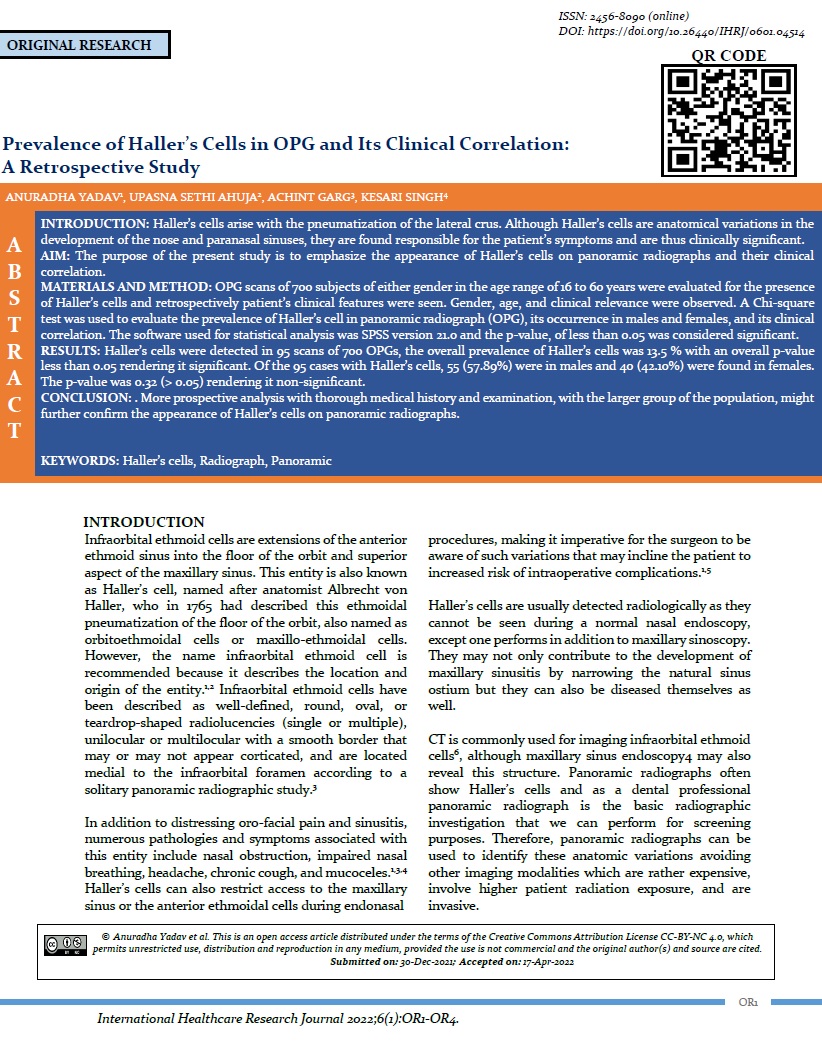Prevalence of Haller’s Cells in OPG and Its Clinical Correlation: A Retrospective Study
Abstract
INTRODUCTION: Haller’s cells arise with the pneumatization of the lateral crus. Although Haller’s cells are anatomical variations in the development of the nose and paranasal sinuses, they are found responsible for the patient’s symptoms and are thus clinically significant. AIM: The purpose of the present study is to emphasize the appearance of Haller’s cells on panoramic radiographs and their clinical correlation. MATERIALS AND METHOD: OPG scans of 700 subjects of either gender in the age range of 16 to 60 years were evaluated for the presence of Haller’s cells and retrospectively patient’s clinical features were seen. Gender, age, and clinical relevance were observed. A Chi-square test was used to evaluate the prevalence of Haller’s cell in panoramic radiograph (OPG), its occurrence in males and females, and its clinical correlation. The software used for statistical analysis was SPSS version 21.0 and the p-value, of less than 0.05 was considered significant. RESULTS: Haller’s cells were detected in 95 scans of 700 OPGs, the overall prevalence of Haller’s cells was 13.5 % with an overall p-value less than 0.05 rendering it significant. Of the 95 cases with Haller’s cells, 55 (57.89%) were in males and 40 (42.10%) were found in females. The p-value was 0.32 (> 0.05) rendering it non-significant. CONCLUSION: . More prospective analysis with thorough medical history and examination, with the larger group of the population, might further confirm the appearance of Haller’s cells on panoramic radiographs.
Downloads
References
Kantarci M, Karasen RM, Alper F, Onbas O, Okur A, Karaman A. Remarkable anatomic variations in paranasal sinus region and their clinical importance. Eur J Radiol. 2004;50(3):296-302. https://doi.org/10.1016/j.ejrad.2003.08.012.
Yanagisawa E, Citardi MJ. Endoscopic view of the infraorbital ethmoid cell (Haller cell). Ear Nose Throat J. 1996;75:406-7.
Ahmad M, Khurana N, Jaberi J, Sampair C, Kuba RK. Prevalence of infraorbital ethmoid (Haller’s cells) on panoramic radiographs. Oral Surg Oral Med Oral Pathol Oral Radiol Oral Endod. 2006;101:658–61.
Yanagisawa E, Marotta JC, Yanagisawa K. Endoscopic view of a mucocele in an infraorbital ethmoid cell (Haller cell). Ear Nose Throat J. 2001;80:364–8.
Lang J. Paranasal sinuses. In: Lang J, editor. Clinical Anatomy of the Nose, Nasal Cavity and Paranasal Sinuses. New York: Thieme, 1989; pp. 88–9.
Basic N, Basic V, Jukic T, Basic M, Jelic M, Hat J. Computed tomographic imaging to determine the frequency of anatomical variations in pneumatization of the ethmoid bone. Eur Arch Otorhinolaryngol. 1999;256:69-71.
Solanki J, Gupta S, Patil N, Kulkarni VV, Singh M, Laller S. Prevelance of Haller's Cells: A Panoramic Radiographic Study. J Clin Diagn Res. 2014;8(9):RC01-4. https://doi.org/10.7860/JCDR/2014/10334.4894.
Raina A, Guledgud MV, Patil K. Infraorbital ethmoid (Haller's) cells: a panoramic radiographic study. Dentomaxillofac Radiol. 2012;41(4):305-8. https://doi.org/10.1259/dmfr/22999207.
Khayam E, Mahabadi AM, Ezoddini F, Golestani MA, Hamzeheil Z, Moeini M, et al. The prevalence of ethmoidal infraorbital cells in panoramic radiography. American Journal of Research Communication 2013; 1(2):109-18
Alkire BC, Bhattacharyya N. An assessment of sinonasal anatomic variants potentially associated with recurrent acute rhinosinusitis. Laryngoscope. 2010 Mar;120(3):631-4. https://doi.org/10.1002/lary.20804.
Sebrechts H, Vlaminck S, Casselman J. Orbital edema resulting from Haller's cell pathology: 3 case reports and review of the literature. Acta Otorhinolaryngol Belg. 2000;54(1):39-43.
Zinreich SJ, Kennedy DW, Rosenbaum AE, Gayler BW, Kumar AJ, Stammberger H. Paranasal sinuses: CT imaging requirements for endoscopic surgery. Radiology 1987; 163:769-75.
Earnwaker J. Anatomic variants in sinonasal CT. Radiographics 1993;13:381-415.
Lloyd GAS. CT of the paranasal sinuses: a study of a control series in relation to endoscopic sinus surgery. J Laryngol Otol. 1990;104:477-81.

Copyright (c) 2022 Anuradha Yadav et al.

This work is licensed under a Creative Commons Attribution-NonCommercial 4.0 International License.


